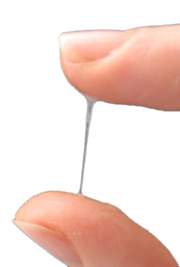- What are the cervical mucus monitoring methods of contraception?
- How does the cervical mucus method work?
- Who can use the cervical mucus method?
- How to use cervical mucus monitoring methods
- Effectiveness of the cervical monitoring methods
- Benefits of the cervical mucus monitoring method
- Limitations of the cervical mucus monitoring method
What are the cervical mucus monitoring methods of contraception?

In order for the method to work effectively as a contraceptive, women must then abstain from vaginal intercourse during the fertile period of the cycle or use alternative methods of contraception if they have sex.
How does the cervical mucus method work?
The cervical mucus method, like other fertility awareness methods, works by enabling women to avoid sex in periods when they are fertile. In doing this, it prevents sperm coming into contact with a live egg and thus prevents pregnancy.
Who can use the cervical mucus method?
Cervical mucus monitoring methods of contraception are suitable for all women who experience menstrual cycles and are able to monitor changes in their cervical mucus on a daily basis (e.g. they are comfortable to touch their bodies and insert their fingers into their vagina). Use of these methods should be delayed however for women who have:
- Recently used emergency contraceptive pills – These women should delay use until normal vaginal secretions return, usually at the start of the next menstrual cycle;
- Who have recently given birth – These women should delay until regular menstrual cycles return, typically six months for breastfeeding and four weeks for non-breastfeeding women; or
- Who have an unusual vaginal discharge – These women should have the discharge checked by a health professional, as it may indicate a serious condition such as a sexually transmitted infections. They should delay use of cervical mucus monitoring methods until the discharge has resolved.
How to use cervical mucus monitoring methods

The effectiveness of cervical mucus monitoring methods in preventing pregnancy is highly dependent on the cooperation of male sexual partner, to abstain or use alternate contraception while the woman is fertile. It may therefore be useful for a woman who chooses to use cervical mucus monitoring methods to visit a family planning clinic with her sexual partner, so that both can learn about the method from a health professional.
Patients who wish to use an alternative method (usually a barrier method rather than abstain during the fertile period, should discuss their options with a health professional. Numerous methods which can be used on demand are available, for example condoms and diaphragms. It is also recommended that women discuss how to use cervical mucus monitoring methods (two of which are outlined below) with a health professional.
The ovulation method (also called the Billings method) requires a woman wishing to prevent pregnancy to monitor both the presence or absence and nature of her cervical mucus. Women using this method should:
- Avoid vaginal intercourse on days of heavy menstrual bleeding, as cervical mucus may appear (indicating fertility) on these days but be difficult to detect. Many women believe, incorrectly, that they cannot become pregnant during menstrual bleeding. While the risk is very slight, particularly for women who have regular menstrual cycles, for those who have short cycles or experience extended periods of bleeding, menstrual bleeding can overlap with the fertile period, which begins five days prior to ovulation. This is because sperm can survive in the uterus for as many as five days following ejaculation;
- Check for cervical secretions every day, in the afternoon, after a period of being upright;
- Have sex only in the evening, as the presence of semen may make it difficult to detect cervical secretions;
- Avoid having sex two days in a row in the period between menstrual bleeding and cervical secretions;
- Consider herself fertile on the day that she notices cervical secretions of any colour or consistency;
- Continue monitoring cervical secretions from the time they appear, until after the "peak" day. On the peak day cervical mucus will be clear, wet and slippery and after the peak day it will become drier and stickier;
- Consider herself fertile for three days after the peak day;
- Avoid unprotected intercourse on fertile days.
The two days method is a simplified cervical mucus monitoring method, which, unlike the ovulation method, does not require a woman to be aware of changes in the nature of her cervical mucus (e.g. colour, consistency). Rather, a woman need only monitor when cervical mucus first appears in her menstrual cycle. Women using this method should:
- Monitor their cervical secretions on a daily basis. This can be done using fingers, checking for secretions on underwear, or using a tissue. Women should be aware that the presence of semen or menstrual blood may make assessing the presence of cervical mucus more difficult;
- Consider themselves fertile when they find cervical secretions on two consecutive days;
- Consider themselves fertile until they have not experienced cervical secretions for two consecutive days (that is, until they have two dry days);
- Use an alternative contraceptive method or abstain from intercourse in the fertile period.
Effectiveness of the cervical monitoring methods

Benefits of the cervical mucus monitoring method
The benefits of cervical monitoring methods include:
- They are natural and do not cause side effects;
- They do not require any special devices or procedures and do not cost anything;
- Women become more knowledgeable about their menstrual cycle when they use the method;
- The are suitable for women with irregular cycle lengths (cycle <26 days or >32 days) who cannot used calendar based methods;
- The two days method is simple and requires minimal monitoring of cervical mucus changes.
Limitations of the cervical mucus monitoring method
The limitations of cervical mucus monitoring methods include:
- Women must monitor changes in their cervical mucus on a daily basis in order to use the methods effectively. This makes the methods inappropriate for some women (e.g. those who have unusual vaginal discharge or are not comfortable checking for secretions or, for the ovulation method, those who are unable to check at certain times of the day) and difficult to use during some stages of the menstrual cycle (e.g. days of heavy menstrual bleeding);
- The ovulation method requires women not only to monitor for the presence of cervical mucus but also to note changes in its consistency, and is therefore more difficult than the two days method to use;
- The ovulation method may require changes to sexual practice (e.g. not having sex two days in a row in the first half of the menstrual cycle and only having sex in the evenings);
- Additional contraceptive methods or abstinence are required if couples wish to have vaginal intercourse in the fertile period;
- The methods do not protect against sexually transmitted infections (STIs), Women who have sexual partners of unknown STI status should, whenever possible, use male or female condoms to protect against STIs.
More information
 |
For more information on different types of contraception, male and female anatomy and related health issues, see Contraception. |
References
- World Health Organisation. Family Planning: A global handbook for providers. 2007. [cited 2009, June 20] Available from: www.who.int/entity/reproductivehealth/publications/family_planning/en/
- Germano, E. Jenning, V. New approaches to fertility awareness based methods: incorporating the standard days and two days methods into practice. J Midwifery Women’s Health. 2006;51:471-7.
- International Planned Parenting Federation. Fertility Awareness. 2009. [cited 2009, November 5] Available from: http://www.plannedparenthood.org/health-topics/birth-control/fertility-awareness-4217.htm
All content and media on the HealthEngine Blog is created and published online for informational purposes only. It is not intended to be a substitute for professional medical advice and should not be relied on as health or personal advice. Always seek the guidance of your doctor or other qualified health professional with any questions you may have regarding your health or a medical condition. Never disregard the advice of a medical professional, or delay in seeking it because of something you have read on this Website. If you think you may have a medical emergency, call your doctor, go to the nearest hospital emergency department, or call the emergency services immediately.







